RBSE Solutions for Class 11 Maths Chapter 5 Complex Numbers and Quadratic Equations Ex 5.2
Rajasthan Board RBSE Solutions for Class 11 Maths Chapter 5 Complex Numbers and Quadratic Equations Ex 5.2 Textbook Exercise Questions and Answers.
Rajasthan Board RBSE Solutions for Class 11 Maths in Hindi Medium & English Medium are part of RBSE Solutions for Class 11. Students can also read RBSE Class 11 Maths Important Questions for exam preparation. Students can also go through RBSE Class 11 Maths Notes to understand and remember the concepts easily.
RBSE Class 11 Maths Solutions Chapter 5 Complex Numbers and Quadratic Equations Ex 5.2
Find the modulus and the arguments of each of the complex numbers in exercIse 1 and 2.
Question 1.
z = - 1 - i√3
Answer:
First Method: Now, comparing, it with
x cos θ + i sin θ
- 1 = r cos θ and -√3 = r sin θ
Squaring and adding,
1 + 3 = r2 cos2 θ + r2 sin2 θ
or 4 = r2 (cos2 θ + sin2 θ)
or r2 = 4 (∵ sin2 θ + cos2 = 1)
or r = 2
Thus r cos θ = - 1 and r sin θ = - √3
cos θ = - \(\frac{1}{2}\) and sin θ = - \(\frac{\sqrt{3}}{2}\)
Thus, line of rotation of angle θ will be in third quadrant.
θ = \(\frac{-2 \pi}{3}\) or \(\frac{4 \pi}{3}\)
Thus, modulus = 2 and argument = - \(\frac{2 \pi}{3}\) or \(\frac{4 \pi}{3}\)
Second Method : Given, z = - 1 - i√3
Comparing with x + ¡y
x = - 1 and y = - √3
∴ Modulus r = \(\sqrt{x^2+y^2}\) (using formula)
r = 4\(\sqrt{(-1)^2+(-\sqrt{3})^2}\)
r = \(\sqrt{1+3}\) = √4 = 2
And argument of given complex number
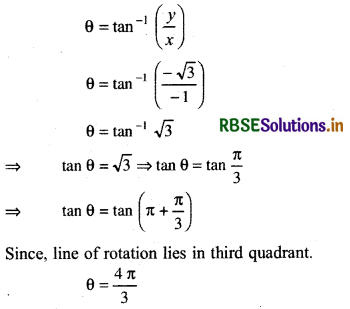

Question 2.
Z = - √3 + i
Answer:
First Method: On comparing z = - √3 + i with r (cos θ + i sin θ)
- √3 = r cos θ and 1 = r sin θ
Squaring and adding,
r2 cos2θ + r2 sin2 θ = 3 + 1
r2 (cos2 + sin2 θ) = 4
or r2 = 4
or r = 2
∴ r cos θ = - √3
and r sin θ = 1
cos θ = - \(\frac{\sqrt{3}}{2}\) and sin θ = \(\frac{1}{2}\)
Then, line of rotation of angle θ will lie in second quadrant.
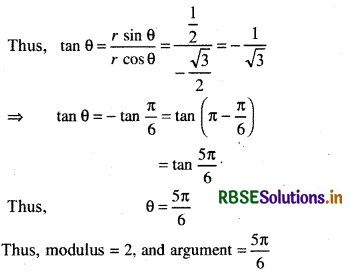
Second Method:
Given, z = - √3 + i
Comparing with x + iy,
x = - √3 (real part) and y = 1 (imaginary part)
Thus, modulus r = \(\sqrt{x^2+y^2}\) (Using formula)
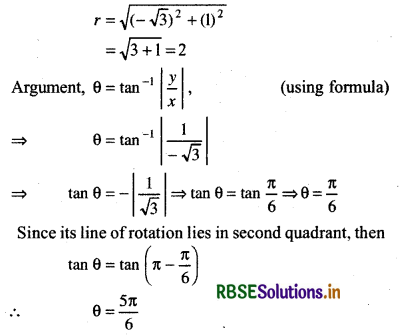

Convert each of the complex numbers given in exercise 3 to 8 in the polar form.
Question 3.
1 - i
Answer:
Let, z = 1 - i = r(cos θ + i sin θ)
On comparing,
r cos θ = 1 and r sin θ = - 1
Squaring and adding.
r2 cos2 θ + r2 sin2 θ = 1 + 1
or r2(cos2 θ + sin2 θ) = 2
or r2 = 2
∴ r = √2
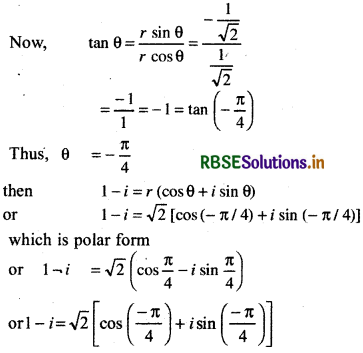
Question 4.
- 1 + i
Answer:
Let, z = - 1 + i = r (cos θ + i sin θ)
Comparing with x + iy
Real part x = - 1, Imaginary part y = 1
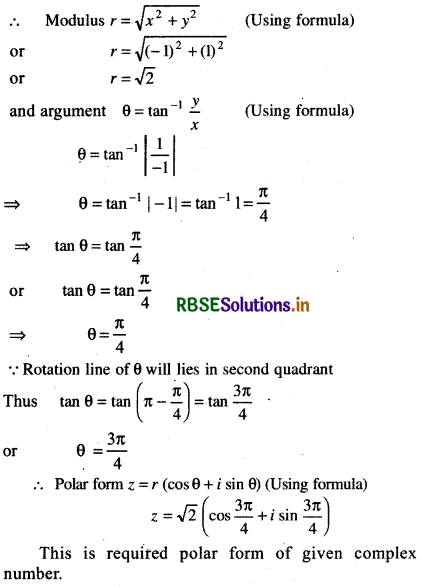

Question 5.
- 1 - i
Answer:
Let z = - 1 - i = (r cos θ + ir sin θ)
On comparing
r cos θ = - 1, and r sin θ = - 1
Squaring and adding,
or r2 cos2 θ + r2 sin2 θ = 1 + 1
or r2 (cos2 θ + sin2 θ) = 2
or r2 = 2 (∵ sin2 θ + cos2 θ = 1)
then cos θ = - \(\frac{1}{\sqrt{2}}\) and sin θ = - \(\frac{1}{\sqrt{2}}\)
For cos θ = - \(\frac{1}{\sqrt{2}}\), rotation line of θ will lie in second or third quadrant.
and for sin θ = - \(\frac{1}{\sqrt{2}}\), rotation line of θ will lie in third quadrant,
Thus we conclude that rotation line of θ will lie in third quadrant.
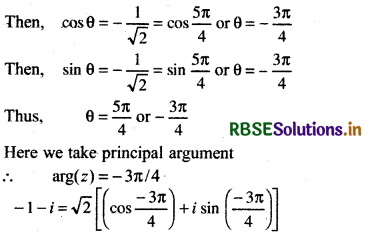
This is the required polar form of given complex number.
Question 6.
- 3
Answer:
Let z = - 3 = r(cos θ + i sin θ)
or z = - 3 + iθ = r(cos θ + i sin θ)
On comparing,
r cos θ = - 3 and r sin θ = 0,
Squaring and adding.
r2 cos2 θ + r2 sin2 θ = 9 + 0
or r2 (cos2 θ + sin2 θ) = 9
or r2 = 9
or r = 3
⇒ r cos θ = - 3 and r sin θ = 0
Thus, cos θ = \(\frac{-3}{3}\) = - 1 and sin θ = 0
⇒ cos θ = - cos 0° .
and sin θ = sin 0° = sin(π - 0)
then θ = π and θ = π or 2π
it concludes, θ = π
Thus, - 3 = 3 (cos π + i sin π) which is in polar form. since rotation line of given complex number will lie on second quadrant.

Question 7.
√3 + i
Answer:
Let z = √3 + i = r(cos θ + i sin θ)
On comparing,
r cos θ = √3 and r sin θ = 1
Squaring and adding,
r2 cos2 θ + r2 sin2 θ = 3 + 1
or r2(cos2 θ - r2 sin2 θ) = 4
or r2 = 4
or r = 2.
⇒ From r cos θ = √3 and r sin θ = 1
Thus, cos θ = \(\frac{\sqrt{3}}{2}\) and sin θ = \(\frac{1}{2}\)
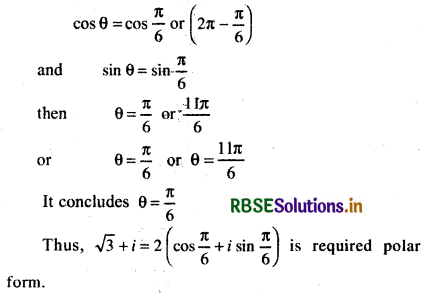
Question 8.
i
Answer:
Let z = 0 + i = r(cos θ + i sin θ)
On comparing
r cos θ = 0 or r sin θ = 1
Squaring and adding,
r2 cos2 θ + r2 sin2 θ = I
or r2 (cos2 θ + sin2 θ) = I
or r2 = 1
or r = 1
⇒ From r cos θ = 0 and r sin θ = I
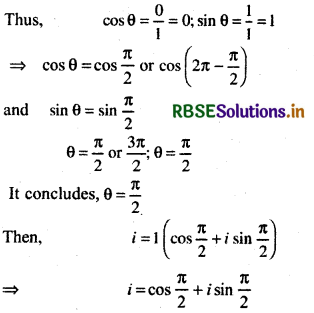
This is required polar form of given complex answer.

- RBSE Solutions for Class 11 Maths Chapter 3 त्रिकोणमितीय फलन Ex 3.1
- RBSE Solutions for Class 11 Maths Chapter 2 संबंध एवं फलन विविध प्रश्नावली
- RBSE Solutions for Class 11 Maths Chapter 2 संबंध एवं फलन Ex 2.3
- RBSE Solutions for Class 11 Maths Chapter 2 संबंध एवं फलन Ex 2.2
- RBSE Solutions for Class 11 Maths Chapter 2 संबंध एवं फलन Ex 2.1
- RBSE Solutions for Class 11 Maths Chapter 1 समुच्चय विविध प्रश्नावली
- RBSE Solutions for Class 11 Maths Chapter 1 समुच्चय Ex 1.6
- RBSE Solutions for Class 11 Maths Chapter 1 समुच्चय Ex 1.5
- RBSE Solutions for Class 11 Maths Chapter 1 समुच्चय Ex 1.4
- RBSE Solutions for Class 11 Maths Chapter 1 समुच्चय Ex 1.3
- RBSE Solutions for Class 11 Maths Chapter 1 समुच्चय Ex 1.2